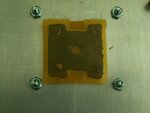mtwieg
Advanced Member level 6
I'm currently working on a project which is basically a 350W boost DC-DC converter and motor driver. Initially I was told the enclosure would be a certain size, which sounded fine, but now I've found that the enclosure is smaller, and is also a polyamide plastic IP65 (meaning it's sealed tight enough to be protected from dust, and from water sprayed at it from a nozzle). So I won't be allowed any airflow between the inside and outside, and the thing is plastic so it has poor thermal conductivity. And from what I can tell the inner compartment is only ~30 cubic inches (and I'm not sure how much of that I'm actually allowed to occupy).
Even if I through my best SMPS design at it, it will probably end up being up to 90% efficient, so I'm looking at >35W of power to get rid of, and I believe it's supposed to operate at 85C ambient. So I need about 1 K/W overall thermal conductivity. Back of the envelope calculations estimate the case's thermal impedance to be ~0.38K/W (purely based on its own material properties and size, nothing based on airflow or convection).
So at this point I'm wondering what, if anything, can be done to keep temperature under control. Heatsinks inside will be useful to reduce hot spots and keep things even, but what about getting the heat out of the enclosure? I don't know if filling it with urethane or some other conductive solid is an option, or how well that could work in practice. I've seen some enclosures where the heatsink pokes out of the enclosure, which would be great, but is it feasible to do this in a way that preserves the enclosure's IP65 capabilities?
Even if I through my best SMPS design at it, it will probably end up being up to 90% efficient, so I'm looking at >35W of power to get rid of, and I believe it's supposed to operate at 85C ambient. So I need about 1 K/W overall thermal conductivity. Back of the envelope calculations estimate the case's thermal impedance to be ~0.38K/W (purely based on its own material properties and size, nothing based on airflow or convection).
So at this point I'm wondering what, if anything, can be done to keep temperature under control. Heatsinks inside will be useful to reduce hot spots and keep things even, but what about getting the heat out of the enclosure? I don't know if filling it with urethane or some other conductive solid is an option, or how well that could work in practice. I've seen some enclosures where the heatsink pokes out of the enclosure, which would be great, but is it feasible to do this in a way that preserves the enclosure's IP65 capabilities?
